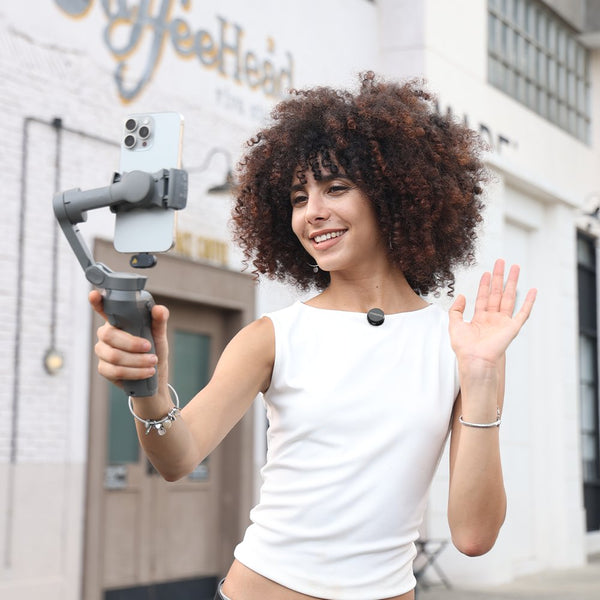Sharing your music to inspire others can truly make a difference. Let your sound reach your audience with clarity by using Maono condenser microphones. Choose the A04 or the PM422 recording microphone options—both bestsellers known for their high-quality, professional sound.
Recording Vocals at Home Using a Condenser Microphone
The rise of home studios has made it easier than ever for singers, songwriters, and independent artists to record and share their music with the world. At the heart of any great home vocal recording setup is a reliable condenser microphone—a go-to for its sensitivity, clarity, and professional sound quality. Whether you're laying down demos, recording full tracks, or simply creating social content, having the right tools and strategy can take your music to the next level. In this guide, we'll explore how to effectively record vocals at home, share your original music online, and connect with your audience through your unique creative journey.
How to Share Your Original Music Online: Platforms and Strategies
Once your vocal track is recorded, the next step is getting it into the ears of listeners. Platforms like SoundCloud, Bandcamp, YouTube, TikTok, Spotify, and Apple Music are essential for distribution and discovery.
-
YouTube allows for video storytelling alongside your music.
-
TikTok offers short-form content that’s highly discoverable.
-
Spotify and Apple Music are ideal for serious releases, often via distributors like DistroKid or TuneCore.
-
SoundCloud is perfect for raw demos and fan-first uploads.
-
Bandcamp enables direct fan support through digital sales and merch.
Tip: Use cross-platform promotion and link all your content back to one main hub—your artist website or Linktree.
Behind the Song: Explaining Your Creative Process to Listeners
Fans crave authenticity, and one powerful way to build a loyal following is by sharing the “why” behind your music. Whether it's in a caption, vlog, or post-recording breakdown, walk your audience through your:
-
Lyric inspiration
-
Melody creation
-
Recording decisions
-
Emotional journey during writing
This kind of transparency makes your music more relatable and deepens the listener’s connection to you as an artist.
From Idea to Release: Documenting Your Songwriting Journey
Use your smartphone and a wireless microphone or lav mic to document your songwriting and vocal recording process. Break it into parts:
-
Idea phase – journal entries, melody hums, lyric notes.
-
Composition – rough chords, vocal scratch tracks.
-
Production – layering vocals and harmonies, mixing attempts.
-
Final vocals – record with your condenser mic for best quality.
You can compile these clips into behind-the-scenes videos or even offer them as bonus content to your fans on Patreon or YouTube Memberships.
Tips for Recording High-Quality Acoustic Tracks at Home
Capturing professional-sounding vocals in a non-treated room can be tricky, but not impossible. Here are some actionable tips:
-
Control your environment
Use thick curtains, rugs, bookshelves, or DIY foam panels to reduce reflections.
-
Mic placement
Position the condenser mic 6–8 inches from your mouth, slightly off-axis to reduce plosives.
-
Use a pop filter
Essential for reducing harsh "p" and "b" sounds.
-
Quiet your space:
Turn off fans, electronics, and record during quieter hours.
Also, consider using a reflexion filter behind your condenser mic to absorb background noise and echo.
Choosing the Best Budget Condenser Mic for Indie Artists
A good condenser mic doesn’t need to break the bank. Two outstanding budget-friendly options are:
Maono A04 USB Condenser Microphone

-
Best for: Beginners, podcasters, and singer-songwriters recording vocals or acoustic instruments.
-
Features:
-
Plug-and-play USB connectivity—no need for an interface.
-
Flat frequency response for accurate vocal capture.
-
Comes with a full kit (mic arm, pop filter, shock mount).
-
Why it stands out: Affordable yet reliable, the Maono A04 delivers professional sound on a beginner's budget, perfect for at-home vocal recording and casual streaming. It's one of the best condenser mics in its price range.
Maono PM422 USB Condenser Microphone

-
Best for: Intermediate users wanting studio-like control.
-
Features:
-
Built-in gain knob, one-touch mute button, and headphone jack for real-time monitoring.
-
Metal build and cardioid pickup pattern to reduce background noise.
-
Excellent clarity and sensitivity for vocals, especially in treated spaces.
-
Why it stands out: With real-time controls and better sound handling, the Maono PM422 is ideal for artists ready to elevate their production quality without investing in XLR gear. It's a good condenser mic for creators who want simple yet powerful tools.
Connecting With Your Audience by Sharing Song Meaning and Inspiration
Don’t just upload the song—share its soul. Fans love hearing what a track means to you, who inspired it, or how it helped you process a life event.
-
Create Instagram Reels or YouTube Shorts where you explain the backstory behind a song.
-
Use wireless microphones to vlog your thoughts while out walking or rehearsing.
-
Consider including a short spoken-word intro or outro in your music video or streaming version.
Storytelling humanizes your art and makes it unforgettable.
Frequently Asked Questions
1. What are the best platforms to share my original songs?
SoundCloud, YouTube, TikTok, Spotify (via DistroKid or CD Baby), and Bandcamp.
2. How do I get more people to listen to my original music?
Promote consistently on social media, collaborate with other creators, and engage with niche communities.
3. Should I post full songs or snippets on social media?
Snippets work best for platforms like TikTok and Instagram. Save full versions for YouTube or streaming platforms.
4. How can I promote my original compositions without a label?
Use hashtags, cross-promote across platforms, run small ad campaigns, and engage with fans directly.
5. How do I copyright my music before sharing it online?
Register your songs with your country’s copyright office or use tools like Songtrust or ASCAP.
6. How can I tell my audience the story behind my song in a compelling way?
Speak from the heart. Use visuals or anecdotes. Keep it short and emotionally honest.
7. Should I release a demo or wait for a fully mastered version?
Demos are great for building hype and getting feedback. Just label them clearly.
8. How often should I release music to build a following?
Consistency matters more than frequency. Aim for 1 song every 4–6 weeks if possible.
9. What type of content can I post to keep fans interested between releases?
Behind-the-scenes clips, songwriting tips, lifestyle vlogs, Q&A sessions, or acoustic versions.
10. Is it helpful to share the songwriting process with followers?
Absolutely—it builds trust and makes fans feel part of your journey.
11. What’s the best way to record vocals at home using a condenser mic?
Use a cardioid condenser mic with a pop filter, record in a quiet space, and speak or sing consistently into the mic.
12. Why do people choose condenser microphones for music recording?
They capture vocal nuances and higher frequencies more accurately than dynamic mics. A condenser microphone provides the clarity needed for professional vocal tracks.
13. How do I get clean, noise-free audio when using a condenser mic?
Reduce room noise, use a pop filter and shock mount, and position the mic away from walls.
14. What’s the best mic placement for recording vocals or acoustic guitar?
For vocals: 6–8 inches away, angled slightly.
For guitar: Near the 12th fret, 8–12 inches away.
15. What audio interface works best with a condenser mic for beginners?
If you wish to use an audio interface, it’s compatible with XLR microphones. The MaonoCaster E2 or AME2 audio interface is highly recommended and you can pair it with Maono XLR mics like the PM500, HD300, PM320 and other brands.
However, if you prefer an easy setup and choose to use a USB condenser mic like the PM422 or A04, you don’t need an audio interface.
16. How do I avoid recording room echo without expensive treatment?
Use rugs, blankets, foam panels, or record in closets or cars for makeshift sound booths.
17. What’s the difference between cardioid and omnidirectional condenser mics?
Cardioid mics pick up sound mainly from the front—ideal for vocals. Omnidirectional picks up sound from all directions.
18. How much post-processing should I do on vocals recorded with a condenser mic?
Basic EQ, compression, de-essing, and reverb usually suffice. Don’t overdo it.
19. Can I record an entire song using just one condenser mic?
Yes! With proper placement, you can record vocals, instruments, and even harmonies using one good condenser mic.
20. What software works best for mixing and editing home-recorded tracks?
Audacity (free), GarageBand (Mac), Reaper, FL Studio, and Ableton Live are all great options.
Final Thoughts
Recording vocals at home using a condenser microphone like the Maono A04 or PM422 allows independent artists to take creative control and produce professional-quality music without leaving the house. Combine this with authentic storytelling, strategic sharing, and audience engagement, and you’ll not only make music—you’ll make a difference.
Your voice matters. Your sound deserves clarity. Let your songs be heard—and felt.
Ready to press record? Get your condenser USB recording microphone from Maono now!



